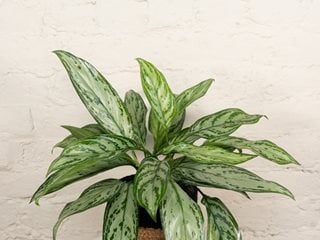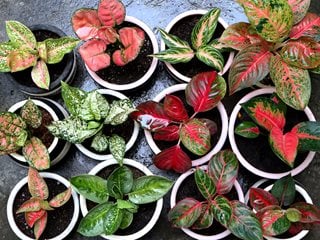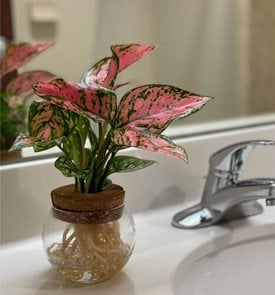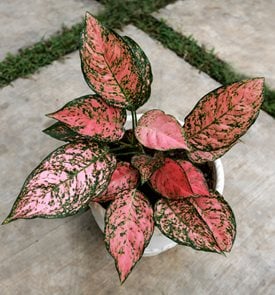A Guide to Growing Chinese Evergreen
Grow this decorative houseplant, with foliage to suit any decor
Aglaonema commutatum 'Maria'. Photo by: dropStock / Shutterstock
For a pop of indoor color, try a Chinese evergreen plant to dress up your home or office. This popular houseplant is revered for its exotic-looking foliage that comes in an array of colors and variegated patterns. A favorite in China, this Asian native is traditionally considered good luck.
Chinese evergreen is a great low-light indoor plant and is easy to grow, even for beginners. It’s considered one of the best foliage plants for cleansing room air of toxins such as benzene and formaldehyde.
Aglaonemas are usually grown indoors, but can also be moved outdoors during summer to adorn containers, or grown outdoors in a shady spot year-round in warmer regions. Here’s how to grow and care for this beautiful plant.
On this page: Basics | Growing Tips | Care and Maintenance | Pictures | Troubleshooting & FAQ's | Display Ideas
On this page:
- BASICS
- GROWING TIPS FOR CHINESE EVERGREEN
- CHINESE EVERGREEN CARE AND MAINTENANCE
- CHINESE EVERGREEN PICTURES
- TROUBLESHOOTING
- DISPLAY IDEAS
BASICS
Botanical name:
Aglaonema spp.
Common names:
Chinese evergreen, Philippine evergreen
Origin:
Native to tropical and subtropical forests of Asia and New Guinea
Zones:
Usually grown indoors as a houseplant, but can be grown outside in Zones 10-11
Plant care level:
Easy to moderate
Growth rate:
Slow growing
Foliage:
Large glossy leaves are long, oval or pointed, occurring on short stems. Colors include shades of green, silver, white, pink and red, with striped, splotched, or symmetrical variegation.
Flowers:
Small white blooms that resemble peace lilies produce a flower spike enclosed by an outer leaf bract. Plants bloom in spring and summer.
Habit and size:
Upright compact or clumping habit; 1 to 3 feet tall and 2 to 4 feet wide
Toxicity:
Chinese evergreen contains calcium oxalate crystals that are toxic to dogs and cats. Plant sap can cause skin irritation or rashes in adults and children. See more Common Poisonous Plants for Dogs and Cats.
Chinese evergreen lookalikes:
Plants that look similar include croton, prayer plant, rubber plant, dumb cane, and calathea.
CHINESE EVERGREEN GROWING TIPS

Chinese evergreen varieties. Photo by: K Abejuela / Shutterstock
Where to grow:
Place in a draft-free area near a window that receives bright indirect light.
Temperature:
Ideal temperatures range between 65 to 80 degrees F. Temperatures below 60 degrees F can cause cold damage. Keep plants away from drafts and heater vents.
Humidity:
Chinese evergreen prefers moist air with a humidity level of 60 to 70%. Increase humidity by using a room humidifier, misting plants frequently or setting pots on a shallow tray filled with pebbles and water. Don’t allow pots to sit in standing water. Plants can also be kept in a more humid room such as a bathroom or kitchen.
Soil type:
Use a peat-based potting mix that is well-draining, with an acidic pH between 5.5 and 6.5. Add sand, perlite or bark to improve drainage.
Pot requirements:
Grow in a pot with adequate drainage holes that is no more than 1 to 2 inches wider than the root ball, which will help prevent root rot.
Propagation:
The easiest way to propagate Chinese evergreen is by root division. Divide in spring and make sure there are multiple young suckers or pieces to work with. Remove plant from pot and brush off the soil to expose the roots. Gently pry apart the suckers, or if potbound, use a sharp knife to cut the root ball into sections. Replant in separate pots using fresh soil.
CHINESE EVERGREEN CARE
How often do you water a Chinese evergreen?
Soil should be kept moist but not soggy. Allow to dry out in between waterings. If soil is dry 2 inches down, it’s time to water. Reduce frequency of watering during winter when plants are semi-dormant.
How much light does a Chinese evergreen need?
Provide low to bright indirect light. Varieties with darker green leaves can tolerate dimmer conditions, while those with light or colorful variegation require brighter light to retain their colors and patterns. Avoid placing plants in direct sunlight, which can cause leaf burn.
Fertilizing:
Apply a balanced liquid houseplant fertilizer at half strength once a month in spring and summer. Avoid fertilizing in winter when plants are semi-dormant.
Pruning:
Trim off brown, yellow, or damaged leaves back to the plant base using a pair of sterile clippers or scissors. Don’t remove live growth, as this can cause damage. Flowers can be removed to direct energy into the foliage.
Cleaning:
Wipe leaves with a damp cloth every few weeks to keep foliage looking fresh.
Repotting:
Remove plants from their pots and replenish with fresh soil every 2 to 3 years, or whenever they appear overgrown or rootbound. Plants prefer to be slightly potbound.
CHINESE EVERGREEN VARIETIES
TROUBLESHOOTING
- Yellow leaves can indicate overwatering or underwatering. Keep plants evenly moist and allow to dry out in between waterings. Yellow leaves can also be a sign of copper deficiency. Make sure to properly fertilize plants.
- Brown leaf tips may be caused by a buildup of salt, chorine, or fluoride in the soil. Repot plants in fresh soil and use distilled water to irrigate plants. Make sure plants are well watered before fertilizing.
- Brown leaves can result from low air humidity, cold drafts or underwatering. Raise room humidity, move plants away from drafty areas, and make sure plants get enough water.
- Scorched leaves are caused by direct sunlight. Move plants to a spot with better lighting conditions, such as bright indirect light.
- Wilted or dropped leaves or a rancid odor can be a sign of root rot. Remove the plant from the pot and examine for dark roots or a mushy root ball. Rinse roots thoroughly to remove contaminated soil. Cut out dead or damaged roots and stems. Treat with hydrogen peroxide solution (1 part 3% hydrogen peroxide, 2 parts water) or a fungicide if needed. Repot in fresh soil and reduce watering. Make sure pots have adequate drainage holes and don’t allow pots to sit in standing water.
- Damaged leaves with curling, yellowing, browning, or small holes may indicate the presence of insects such as mealybugs, scale, spider mites, or aphids. Inspect affected leaves with a magnifier to identify the pest. Rinse off leaves with water or use a cotton swab dipped in 70% rubbing alcohol to remove and kill eggs and insects. If insects persist, apply insecticidal soap or horticultural oil according to instructions. Test a small area of the plant first to make sure it’s not sensitive to soap or oil. Reapply as needed.
- Leaf damage including discoloration, holes or patchy brown spots can indicate fungal disease such as anthracnose or leaf spot. Use a copper fungicide according to instructions. Make sure it specifies safe for Chinese evergreen, as their leaves are quite tender.
- Curled leaves can be due to a number of factors, including underwatering, overwatering, low humidity, cold stress, insect predators, or over-fertilization. Diagnose and treat as necessary.
- Small flying insects during warmer summer months may indicate the presence of fungus gnats. These bugs are harmless, though they can be annoying. Reduce watering, mix diatomaceous earth into the top inch of soil (wear a mask to prevent inhalation), or try decorative pebbles as a barrier.
DISPLAY IDEAS
- Plant in a colorful ceramic pot and display on a shady patio or deck during summer.
- Place a smaller specimen in a bathroom on a shelf or in a macrame hanger where it will benefit from the added room humidity.
- Dress up a dark hallway or corner of a room with a darker colored aglaonema that can tolerate lower light levels.
- Create a centerpiece on a dining room table with Chinese evergreen, poinsettias, and colorful garlands for a festive holiday display.
- Place on a plant stand next to your bed for air cleansing benefits while you sleep.
- Spruce up an office desk, boardroom table, or lobby counter with one or more Chinese evergreen specimens.
- Display a larger specimen on the floor of a home entryway or office lobby.
RELATED:
21 Best Indoor Plants
7 Common Houseplant Pests
A Guide to Growing Pothos
The Best Philodendrons to Grow Indoors












